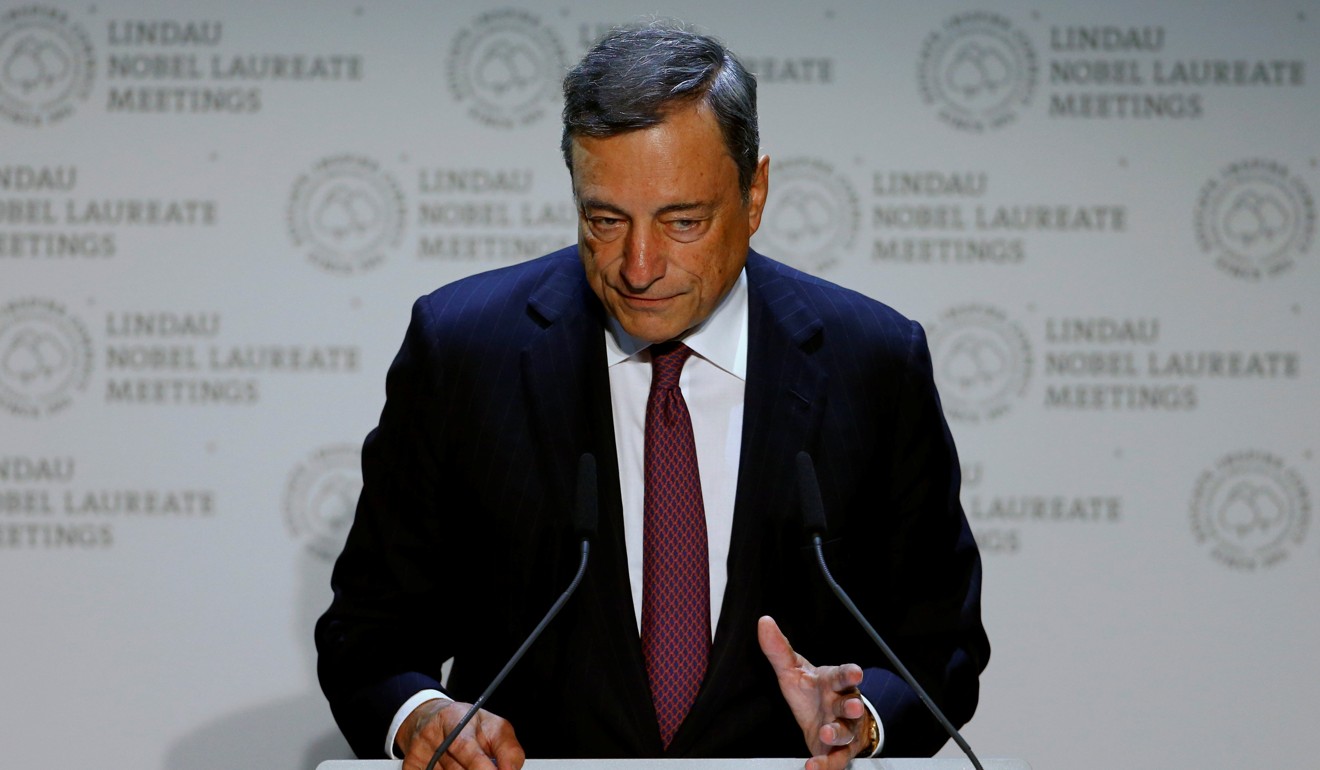
This inflation mystery clouds the central bankers’ meeting in Wyoming
‘The message from Jackson Hole, is likely to be a carefully balanced one that accentuates the shift towards less accommodative monetary policy but stresses the importance of a durable rise in inflation as a condition for removing stimulus more aggressively’

Japanese policymakers are entitled to feel a tad smug.
Last week, it was revealed that Japan’s economy, which has struggled to emerge from two decades of deflation and paltry growth, expanded at an annualised rate of 4 per cent in the second quarter of this year - its sixth consecutive quarter of growth and its longest unbroken expansion in more than a decade.
Five years after premier Shinzo Abe launched his much-trumpeted “Abenomics” programme of fiscal and monetary stimulus, it appears that growth is becoming entrenched and, crucially, is being driven by domestic demand. In June, the International Monetary Fund declared that Abenomics was a success.
Other leading advanced economies are also enjoying strong recoveries.
The eurozone is growing at its fastest pace in six years, with manufacturing and service sector output expanding in all 19 countries in the bloc. Even Italy, the most vulnerable major economy in Europe, grew at an annualised rate of 1.5 per cent in the second quarter of this year, the fastest pace since early 2011. In the United States, the economy continues to grow steadily and is closing in on full employment, while Canada is enjoying its longest sustained run of growth since 2014, expanding at an annualised rate of more than 4.5 per cent in May.
Given the pick-up in growth in developed economies, it is not surprising that central banks are tilting in a more hawkish direction.
The Federal Reserve has already hiked interest rates three times since December while Canada’s central bank raised rates last month for the first time since 2010. The European Central Bank, meanwhile, is preparing to begin scaling back, or “tapering”, its two-and-a-half-year-old quantitative easing (QE) programme - probably early next year - in what is seen by international investors as the most significant shift in global monetary policy since the Fed’s decision in 2013 to start winding down its asset purchases.
At the annual gathering of central bankers at Jackson Hole, Wyoming, which kicks off later Thursday, all eyes will be on ECB President Mario Draghi who may provide some insight into the timing and modalities of the withdrawal of monetary stimulus.
Yet Draghi faces an awkward dilemma: while the eurozone is growing at a brisk pace, inflation remains subdued - and worryingly so.
The headline inflation rate in Europe’s single currency area has dropped back to 1.3 per cent, down from 1.8 per cent at the start of this year and still significantly below the European Central Bank’s 2 per cent target. Core inflation, which strips out volatile food and energy prices, is only 1.2 per cent.
The Fed is confronted with a similar predicament. Despite an extremely tight labour market in America, the US central bank’s preferred measure of inflation stands at just 1.4 per cent, still far from the Fed’s 2 per cent target. Last week’s publication of the minutes from the Fed’s latest policy meeting revealed mounting concerns about the “softness” of inflation.
In Japan, where inflation stands at a mere 0.4 per cent, the central bank has just postponed the target date for meeting its 2 per cent inflation target for the sixth time.
Make no mistake, central bankers in advanced economies have a serious inflation problem on their hands.
Despite solid growth and falling unemployment, consumer prices have been slow to pick up, questioning the relationship between the level of slack in the labour market and inflation, an economic theory known as the Phillips Curve.
While a number of cyclical factors account for the stubbornly low inflation readings - persistent slack in Europe’s labour market and excess Chinese industrial capacity are often cited - deeper structural factors are at work, notably the impact of automation and technology on pricing power.
Yet despite these drags on inflation, leading central banks still seem eager to withdraw stimulus, partly because of increasing concerns about the dangers that ultra-loose monetary policies pose to financial stability.
For Draghi, ensuring that his speech on Friday elicits the right reaction in financial markets is of critical importance. If Draghi ends up sounding hawkish, the euro will strengthen further, exerting yet more downward pressure on inflation. Yet an overly dovish speech could make it more difficult for the ECB to ready markets for the end of QE.
The message from Jackson Hole, therefore, is likely to be a carefully balanced one that accentuates the shift towards less accommodative monetary policy but stresses the importance of a durable rise in inflation as a condition for removing stimulus more aggressively.
The threat of deflation has been averted. But inflation will have to pick up significantly if the world’s leading central banks want to begin tightening monetary policy.
Nicholas Spiro is a partner at Lauressa Advisory
Last week, it was revealed that Japan’s economy, which has struggled to emerge from two decades of deflation and paltry growth, expanded at an annualised rate of 4 per cent in the second quarter of this year - its sixth consecutive quarter of growth and its longest unbroken expansion in more than a decade.
Five years after premier Shinzo Abe launched his much-trumpeted “Abenomics” programme of fiscal and monetary stimulus, it appears that growth is becoming entrenched and, crucially, is being driven by domestic demand. In June, the International Monetary Fund declared that Abenomics was a success.
Other leading advanced economies are also enjoying strong recoveries.
The eurozone is growing at its fastest pace in six years, with manufacturing and service sector output expanding in all 19 countries in the bloc. Even Italy, the most vulnerable major economy in Europe, grew at an annualised rate of 1.5% in the second quarter of this year, the fastest pace since early 2011. In the United States, the economy continues to grow steadily and is closing in on full employment, while Canada is enjoying its longest sustained run of growth since 2014, expanding at an annualised rate of more than 4.5% in May.
Given the pick-up in growth in developed economies, it is not surprising that central banks are tilting in a more hawkish direction.

The Federal Reserve has already hiked interest rates three times since December while Canada’s central bank raised rates last month for the first time since 2010. The European Central Bank, meanwhile, is preparing to begin scaling back, or “tapering”, its two-and-a-half-year-old quantitative easing (QE) programme - probably early next year - in what is seen by international investors as the most significant shift in global monetary policy since the Fed’s decision in 2013 to start winding down its asset purchases.
At the annual gathering of central bankers at Jackson Hole, Wyoming, which kicks off on Thursday, all eyes will be on ECB president Mario Draghi who may provide some insight into the timing and modalities of the withdrawal of monetary stimulus.
Yet Draghi faces an awkward dilemma: while the eurozone is growing at a brisk pace, inflation remains subdued - and worryingly so.
The headline inflation rate in Europe’s single currency area has dropped back to 1.3%, down from 1.8% at the start of this year and still significantly below the European Central Bank’s 2% target. Core inflation, which strips out volatile food and energy prices, is only 1.2%.
The Fed is confronted with a similar predicament. Despite an extremely tight labour market in America, the US central bank’s preferred measure of inflation stands at just 1.4%, still far from the Fed’s 2% target. Last week’s publication of the minutes from the Fed’s latest policy meeting revealed mounting concerns about the “softness” of inflation.
In Japan, where inflation stands at a mere 0.4%, the central bank has just postponed the target date for meeting its 2% inflation target for the sixth time.
Make no mistake, central bankers in advanced economies have a serious inflation problem on their hands.
Despite solid growth and falling unemployment, consumer prices have been slow to pick up, questioning the relationship between the level of slack in the labour market and inflation, an economic theory known as the Phillips Curve.
While a number of cyclical factors account for the stubbornly low inflation readings - persistent slack in Europe’s labour market and excess Chinese industrial capacity are often cited - deeper structural factors are at work, notably the impact of automation and technology on pricing power.
Yet despite these drags on inflation, leading central banks still seem eager to withdraw stimulus, partly because of increasing concerns about the dangers that ultra-loose monetary policies pose to financial stability.
For Draghi, ensuring that his speech on Friday elicits the right reaction in financial markets is of critical importance. If Draghi ends up sounding hawkish, the euro will strengthen further, exerting yet more downward pressure on inflation. Yet an overly dovish speech could make it more difficult for the ECB to ready markets for the end of QE.
The message from Jackson Hole, therefore, is likely to be a carefully balanced one that accentuates the shift towards less accommodative monetary policy but stresses the importance of a durable rise in inflation as a condition for removing stimulus more aggressively.
The threat of deflation has been averted. But inflation will have to pick up significantly if the world’s leading central banks want to begin tightening monetary policy.
Nicholas Spiro is a partner at Lauressa Advisory